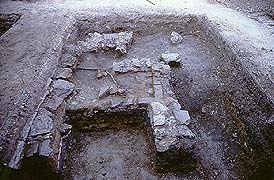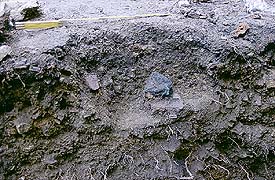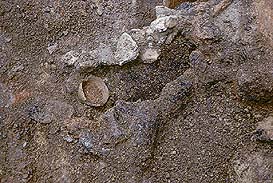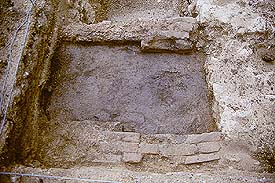The Český Krumlov Castle, the silver smelting works from the turn of the 13th and 14th century
The metallurgical works remains were found in the year 1995 during the 2nd chateau courtyard archaeological research work (The archaeological research of the Český Krumlov medieval Castle). They gradually managed to uncover the construction remains of several metallurgical apparatus - smelting furnaces used to smelt copper from the initial phase - ore roasting, spalling, so-called "little stone" roasting, copper reduction and "black copper" refinement.

|

|
|
| Pic. 1 | Pic. 2 |
Object No. 1 (picture 1), some construction remains made of stones and bricks are said to have been the preparation plant being used to roast ore, were preserved. Near-by half-ground object No. 2 (picture 2), a round shaft with burnt erasure signs. The object was perceptibly connected with the non-preserved metallurgical apparatus - smelting furnaces. Objects No. 3, 4 are thought to have been the smelting apparatus with some with form and construction differences, and a large variety of metallurgical waste indicates their appurtenance to various technological phases. Object No. 3 (picture 3) should be the melting-pot furnace remains. The furnace smelted and refined coloured metal and silver in order to be used for acid test purposes and alloy production. The whole melting-pot a pottery vessel with a triangular mouth was found in the mouth of the heating channel. Object No. 4 a simple construction with the lined, black burnt bottom and walls made of bricks was originally used to smelt "little stone" and produce black copper.

|

|
|
| Pic. 3 | Pic. 4 |
All the discovered metallurgical objects dating from the turn of the 13th and 14th century are connected chronologically, spaciously and functionally. The maximum distance between them is 15 metres, and that is the right area for the production unit. The apparatus do not clash, and because of the large variety they must have been used for different operations. The objects were ordered in the line from the west to the east in harmony with technological processes: ore treatment, ore smelting, etc.
It ranks among the best-searched medieval non-metallurgical works in Bohemia, and one of the best-documented examples in Europe. It is very possible that the final product was not copper, but rare metal - silver and perhaps gold.
Any other comparable example from the castle surroundings concerning the entire metallurgical process which includes transport and ore production has not been known so far. They managed to detect the unique stage of the production concentration at the Český Krumlov Castle. The large place of work was located in a well-fortified and thoroughfare exposed zone between the both Castle centres. The ore and slag specimens taken from the individual objects helped to find the bearings of the metallurgical works location. The analysed malachite ore specimen found in the cultural layers connected with the metallurgical works was very rich in silver, but the produced black copper shows only a very slight metal content. It was probably caused by taking silver away from the copper inter-product.
The metallurgical place of work dating from the turn of the 13th and 14th century and its remains were discovered in the 2nd courtyard of the Český Krumlov Castle, and are the direct evidence of local metallurgical ore process more than 150 years earlier than we originally assumed. As it was already said, the final product was silver or perhaps gold. Regarding rare metal it is necessary to consider it as one of the substantial power and prestige resources of the South Bohemia sovereigns - The House of Vítkovci and The House of Rožmberk.
(me)
Further information :
History
of mining in the town of Český Krumlov
The
archaeological researches in the town of Český
Krumlov

